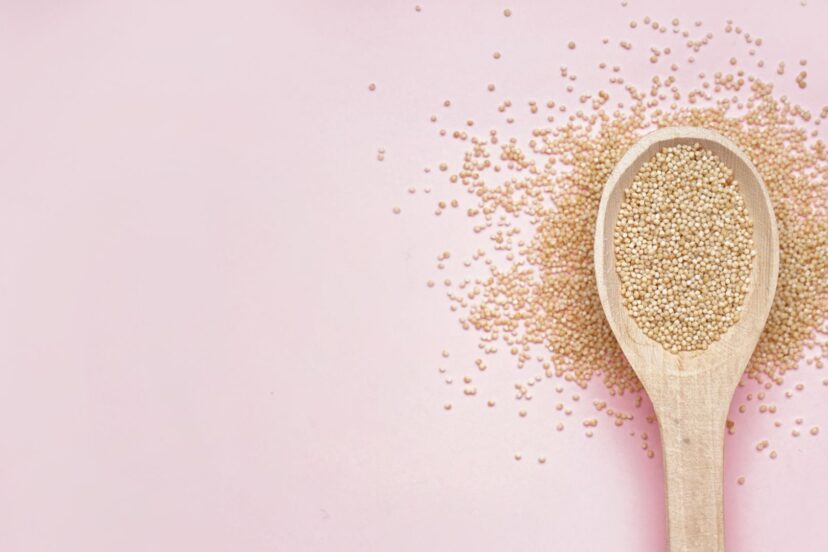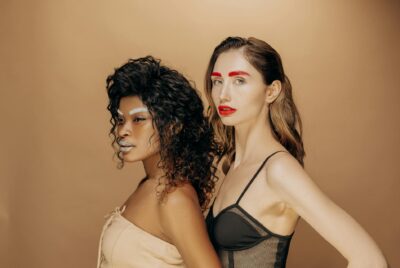Clean Beauty Shampoo: The Quinoa Protein Miracle
Have you ever wondered why your latest clean beauty shampoo makes your hair feel like it’s been wrapped in silk? That’s the Quinoa Protein in your Clean Beauty Shampoo!
Yes, you heard it right, quinoa isn’t just a fancy grain for your salads anymore!
What is Quinoa Protein?
Quinoa protein, often found in various health foods and cosmetic products, is derived from quinoa grains, which originate from the Andes region of South America.
Quinoa has been a staple food source in this region due to its robust nutritional profile.
Now, in terms of hair care, quinoa protein is highly valued for its beneficial components, such as:
– Amino Acids: Quinoa is rich in amino acids, which are the building blocks of protein. This makes it especially good for your hair because hair is primarily made up of a protein called keratin.
– Vitamins and Minerals: Quinoa is also a good source of important vitamins and minerals such as magnesium, iron, copper, and phosphorus. These nutrients are vital for hair health as they nourish the scalp and hair follicles.
So, if hair growth is an issue for you, a clean beauty shampoo with quinoa protein is what you need.
But how does this grain turn into a hair care miracle, you ask?
Picture this: the quinoa seeds are gently coaxed into releasing their protein-rich essence, which is then purified and added to your shampoo.
1. Harvesting and Cleaning:
Quinoa grains are harvested when they mature. The harvested grains are then thoroughly cleaned to remove saponins, a naturally occurring chemical compound that coats the outside of the quinoa grains and can be bitter and irritant.
2. Extraction:
After cleaning, the protein is extracted from the quinoa grains. This is usually done using a process called hydrolysis. During hydrolysis, enzymes or other chemical agents break down the proteins present in the quinoa into smaller peptides and amino acids. This breakdown is crucial as it makes the proteins more soluble and easier to integrate into hair care formulations.
3. Refinement:
The extracted protein solution may be further refined to increase the concentration of proteins and remove any unwanted residues or impurities. This ensures that you get a good quality final product.
4. Formulation:
The refined quinoa protein extract is then formulated into various hair care products depending on the brand and their own concoctions and potions.
The Science Behind Quinoa Protein (Geeking Out Time!)
Now, let’s get our geek on for a moment and dive into why quinoa protein is the Diva of hair care ingredients.
First off, as mentioned above, quinoa protein boasts an amino acid profile that’s quite similar to keratin, the protein naturally found in your hair. It’s like finding a long-lost twin in the world of hair care ingredients!
But why is this match so important?
Because when quinoa protein meets your hair, it’s like a perfect handshake, allowing it to penetrate and nourish each strand from the inside out.
This process is akin to filling up the tiny cracks in a dried-up riverbed, ensuring that your hair is hydrated and resilient against breakage.
Moreover, quinoa protein doesn’t just stop at a hearty hello. It goes the extra mile by forming an “armour” around each hair strand, safeguarding it against the harsh realities of heat styling, pollution, and that occasional dye job we swear we won’t do again (but let’s be honest, we will).
Quinoa Protein: Your Hair’s New Best Friend
Nourishment and Protection
Well, this mighty ingredient coats each hair shaft like a protective cloak, shielding it from environmental villains and locking in moisture.
Just as a well-nourished plant sprouts from rich soil, quinoa protein helps create the perfect environment for healthy hair growth. It’s like feeding your hair a gourmet meal packed with all the nutrients it needs to thrive.
Strength and Elasticity
Now, let’s talk about the dreaded B-word: Breakage!
We’ve all been there—brushing our hair and watching in horror as strands decide to part ways. Here’s where quinoa protein steps in, acting like a gym trainer for your hair.
a.k.a Cuticle Smoothing
The outermost layer of the hair, known as the cuticle, consists of overlapping scales. Damage to the cuticle can lead to frizzy hair and increased susceptibility to breakage.
The protective film quinoa protein creates over the hair strand helps to smooth down these scales, reducing mechanical friction between hair strands during styling and brushing. This not only prevents the hair from tangling but also minimizes the damage that can lead to breakage.
Quinoa protein pumps up the strength of each strand of hair, making it more resilient and less likely to snap under pressure. This means you can brush, style, and twirl your hair to your heart’s content, knowing it’s got the strength to withstand a little extra love.
Now, let’s talk about the E-word: Elasticity!
Elasticity is what gives your hair the ability to stretch and bounce back without breaking. It’s the difference between a rubber band that snaps and one that stretches.
Quinoa protein boosts elasticity, giving your hair the flexibility to move freely and gracefully. Imagine doing that slow-motion hair flip without fearing the consequences. Thanks to quinoa protein, your hair can be as free and flexible as a world-class gymnast.
Quinoa, Elasticity and colored hair…an example
Let me give you an example so you can understand what happens when your hair lacks elasticity and the wonders quinoa can do for your mane!
Coloring your hair reduces its elasticity primarily because the chemical processes involved can significantly affect the hair’s internal and external structure. Here’s a breakdown of why this happens:
Cuticle Damage
Hair color treatments typically involve chemicals like ammonia or other alkaline agents that open up the cuticle (the protective outer layer of the hair) to allow color to penetrate into the cortex (the inner part of the hair where the melanin that gives hair its natural color is located).
Opening the cuticle can leave the hair vulnerable to external damage and moisture loss, which affects its strength and elasticity.
Cortex Alteration
The main objective of hair dye is to change the color of the hair, which involves a chemical reaction within the cortex. Permanent dyes often use peroxide to remove the natural pigment (melanin) and replace it with new color.
This process can break down the natural hair proteins (such as keratin), weakening the hair structure. Weaker hair is less elastic and more prone to breaking under tension.
Protein Loss
The chemical processes used in hair coloring can lead to protein loss in the hair. Proteins are essential for hair strength and elasticity. When these proteins are damaged or depleted, the hair becomes weaker and less able to return to its original shape after being stretched, leading to reduced elasticity.
Moisture Loss
Chemical treatments can disrupt the natural moisture balance of the hair. When the hair’s protective cuticle is compromised, it can lose moisture more easily, leading to dryness. Dry hair is brittle and less flexible, thereby more prone to snapping when stretched.
In a nutshell, if you are chemically treating your hair, a clean beauty shampoo with quinoa protein is your ally! It will protect your hair cuticle, bring back moisture and it will boost your hair’s elasticity. 🥰
Quinoa Protein in Action: Transforming Your Hair
So, you’re now in the know about the wonders of quinoa protein for your hair, and I bet you’re itching to see this superhero in action.

Incorporating Quinoa Protein into Your Hair Care Routine
Finding the right clean beauty shampoo with quinoa protein might feel a bit like online dating—overwhelming at first but totally worth it when you find “the one.”
Here’s a little cheat sheet to make your quest a tad easier:
1. Read the Labels:
Just like scanning a potential date’s profile for red flags, check your ingredient list. Quinoa protein might be listed as “hydrolyzed quinoa.” If it’s near the top of the list, you’ve hit the jackpot, as ingredients are listed in order of concentration.
2. Seek Out Clean Beauty Brands:
Opt for brands that are committed to using natural, non-toxic ingredients. These companies are more likely to use quinoa protein in its most beneficial form, without the nasty chemicals that can strip away its goodness.
I’ve got a rec for you! Try this clean beauty shampoo!
Once you’ve found your perfect match, here’s how to get the most out of your new relationship:
- Consistency is Key: Like any good relationship, consistency is crucial. Use your quinoa protein-enriched shampoo regularly to see significant improvements in hair health and vitality.
- Don’t Overdo It: While it’s tempting to use your new shampoo every day, over-washing can lead to dryness. Stick to washing your hair 2-3 times a week, depending on your hair type and lifestyle.
Remember these 3 things about quinoa protein
1. Hydrolyzed Protein
Quinoa protein used in hair care products is typically hydrolyzed. This means the protein is broken down into smaller peptides and amino acids.
These smaller molecules can get into the hair shaft more easily than larger protein molecules. Once inside the hair shaft, they help to repair and strengthen the internal structure of the hair.
2. Film-Forming Properties
Quinoa protein has excellent film-forming abilities. When applied to the hair, it forms a protective film over each strand. This film not only helps to smooth the cuticle (the outer layer of the hair), but also acts as a barrier to seal in moisture.
This is particularly beneficial for people with dry or brittle hair, as it prevents moisture loss caused by environmental factors like sun exposure and wind.
3. Balancing Hair Porosity
Hair porosity refers to the hair’s ability to absorb and retain moisture. Damaged or chemically treated hair often has high porosity, which means it absorbs moisture quickly but loses it just as fast.
Quinoa protein can help to balance the porosity of the hair by filling in the gaps and holes in the hair cuticle. This results in improved moisture retention and less susceptibility to damage.

AROMATICA Quinoa Protein Shampoo | Provides Protein and Nourishment to Extremely Damaged Hair | Free from Sulfate + Silicone 🌸
“Did you know that rice water contains inositol, a carbohydrate that can help repair damaged hair and promote overall hair health. Read my article about rice water here”
FAQs on Quinoa Protein in Clean Beauty Shampoo
Q: Can all hair types benefit from quinoa protein?
Absolutely! Quinoa protein is a versatile ingredient that benefits all hair types by providing essential nutrients and protecting against damage.
Q: How soon will I see results from using a quinoa protein shampoo?
Patience, my friend. While some benefits like increased softness can be noticed almost immediately, others, such as reduced breakage and enhanced strength, may take a few weeks of consistent use to become apparent.
Q: Can I use quinoa protein shampoos if I have color-treated hair?
Yes, and you should! Quinoa protein can help protect color-treated hair from fading and damage by sealing in moisture and adding a protective layer around the hair shaft.
Q: Are there any side effects to using quinoa protein on my hair?
Quinoa protein is generally safe and beneficial for all hair types. However, if you have a quinoa allergy, it’s best to do a patch test first or consult with a dermatologist.
And there you have it—a complete guide to transforming your hair care routine with the power of quinoa protein. Remember, great hair doesn’t happen by chance; it happens by adding quinoa protein to your shopping cart (and your hair care routine)!







